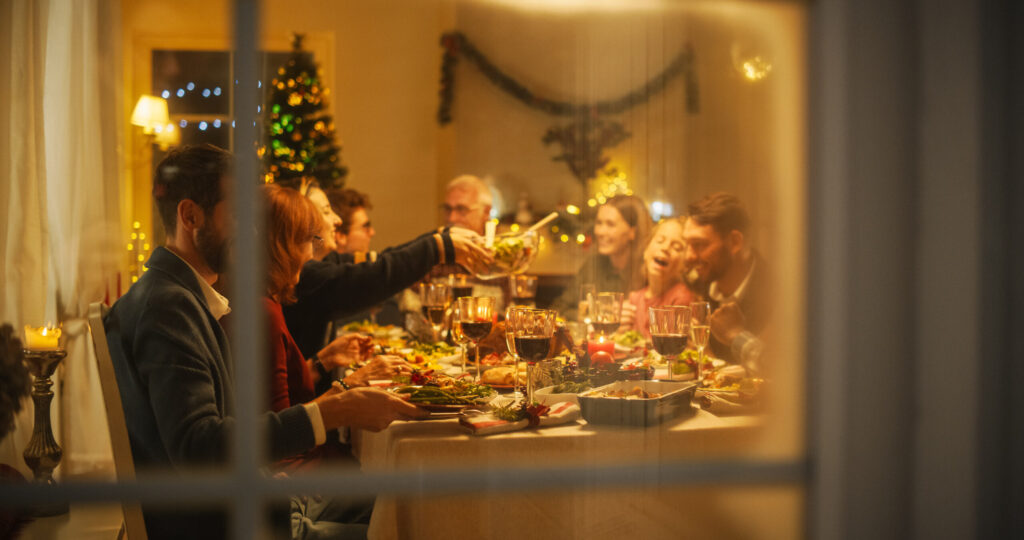Thanksgiving is a time for gratitude, great food, and gathering with loved ones. But if you’re hosting this year, you might be overlooking one crucial detail: how drastically a house full of guests will affect your home’s temperature.
Picture this: 15-20 people crowded into your living room, kids running around, the oven cranking out a turkey for hours, and multiple dishes simmering on the stovetop. It’s cold outside, but inside? Your home might feel more like a sauna than a cozy autumn gathering.
The good news is that with a little planning and some smart thermostat strategies, you can keep everyone comfortable without constantly fiddling with the controls. Here’s how to manage your home’s climate when you’re hosting the big feast.
Understanding the “Body Heat Effect”
Here’s something most hosts don’t realize: every person in your home generates approximately 330 BTUs of heat per hour. That might not sound like much, but when you have 15 guests, it’s the equivalent of running a 1,500-watt space heater in your living room.
Add to that the heat from your kitchen—where the oven, stovetop, and multiple cooking appliances are running simultaneously—and you’ve got a significant heat load your HVAC system wasn’t accounting for when you set that thermostat this morning.
This is why your normal temperature settings simply won’t work on Thanksgiving Day. What keeps your home at a comfortable 72°F on a regular November evening will leave everyone sweating and fanning themselves once the guests arrive and the cooking begins.
Pre-Thanksgiving Thermostat Strategy
The key to a comfortable Thanksgiving is preparation. Don’t wait until guests are knocking at the door to think about temperature management.
Days Before:
Start by lowering your thermostat 2-3 degrees below your normal setting about 24 hours before guests arrive. This gives your home time to stabilize at the cooler temperature and ensures you’re not starting from a place that’s already too warm.
While you’re at it, walk through your home and check that all vents are open and unobstructed in the areas where people will gather. That decorative basket sitting on a floor vent? Move it. Furniture blocking an air return? Rearrange now, not when guests are watching.
This is also the perfect time to test your system and make sure everything is working properly. The last thing you need is to discover a problem when you have a house full of people. If you haven’t had maintenance done this fall, consider scheduling a fall maintenance appointment to ensure everything runs smoothly.
Day Of:
On Thanksgiving morning, set your thermostat to 68-69°F—a full 3-4 degrees cooler than you might normally prefer. Yes, it might feel slightly chilly when you first wake up, but trust the process.
Once you start cooking and guests begin arriving (usually around mid-morning or early afternoon), plan to adjust the temperature down another degree. If you have a programmable thermostat, you can set this schedule in advance based on your typical Thanksgiving timeline.
Zone Management for Different Areas
Not all rooms in your home will heat up equally on Thanksgiving, which means a one-size-fits-all thermostat setting won’t work.
Living and Dining Areas (High Traffic):
These are your gathering spaces where most people will congregate. Keep these rooms on the cooler side since body heat will naturally warm them up. If things get too warm despite your thermostat adjustments, don’t be afraid to crack open a window slightly. A small amount of fresh air circulation is actually better for your HVAC system than constant cycling between heating and cooling.
The Kitchen:
Expect your kitchen to be 10-15 degrees warmer than the rest of your home. Between the oven running for hours, stovetop burners going, and multiple people working in a confined space, this room becomes its own microclimate.
Use your exhaust fan strategically—not just for removing cooking odors, but for venting excess heat. If your kitchen has a door, keep it closed as much as possible while cooking to contain the heat. Yes, this goes against the open-concept entertaining trend, but your HVAC system will thank you.
Bedrooms and Quiet Spaces:
These areas might actually feel chilly since they won’t benefit from body heat and cooking warmth. If you have guests who need to step away from the crowd—elderly relatives, someone with a headache, or kids needing nap time—these rooms might need slightly warmer settings. Consider closing vents partially in completely unused rooms to redirect airflow to the spaces that need it.
Ventilation and Air Quality
Temperature isn’t the only comfort factor when you’re hosting. With a crowd in your home and hours of cooking, air quality becomes crucial.
Run your bathroom exhaust fans to help with overall air circulation throughout the house. This creates negative pressure that helps draw air through your home, preventing that stuffy feeling that develops when too many people are in one space.
Crack a window in your cooking area, even if it’s just an inch or two. This releases steam and excess heat while bringing in fresh air—and it’s especially helpful if anyone in your home is sensitive to cooking smells or smoke.
Here’s a crucial step many hosts forget: change your air filter before the holiday. Cooking particles, extra foot traffic, and additional people in your home mean your HVAC system is working harder and your filter will clog faster than usual. A clean filter ensures better airflow and helps manage all those cooking odors. For homes that frequently entertain, you might want to learn more about indoor air quality solutions that go beyond basic filtration.
Finally, if you have ceiling fans, run them on reverse (clockwise) to gently circulate warm air without creating uncomfortable drafts.
Common Mistakes to Avoid
Even with the best intentions, it’s easy to make HVAC mistakes on Thanksgiving. Here are the most common ones:
Don’t constantly adjust your thermostat up and down. It’s tempting to fiddle with the controls every time someone says they’re hot or cold, but this actually causes your system to work much harder and less efficiently. Set it lower than normal in the morning and resist the urge to touch it unless there’s a significant comfort issue.
Don’t close too many vents. While it seems logical to close vents in unused rooms to “redirect” air, closing more than 20% of your vents creates pressure imbalances in your ductwork. This forces your system to work harder and can actually reduce efficiency in the rooms where you want airflow.
Don’t forget about humidity. Cooking releases a tremendous amount of moisture into your home. If the air starts feeling muggy or your windows are fogging up, you’re dealing with excess humidity. Run those bathroom fans longer than you think you need to, and don’t hesitate to crack windows even if it seems counterintuitive.
Don’t ignore unusual noises or smells from your HVAC system. When your system is working harder than normal, existing issues can become more apparent. If you hear grinding, squealing, or smell anything burning (and it’s not from the kitchen), turn off your system and call for help. Better to address it now than have a complete breakdown.
Keep the Focus Where It Belongs
At the end of the day, Thanksgiving is about connection, not thermostat settings. The goal of all this planning is simple: ensure that HVAC concerns don’t distract from the time with family and friends.
By lowering your thermostat before guests arrive, managing airflow strategically, and avoiding the common pitfalls, you can create a comfortable environment where everyone can focus on what really matters—good food, good company, and gratitude.
If you have questions about your system’s capacity to handle holiday hosting, or if something doesn’t seem quite right when you test your HVAC this week, don’t hesitate to reach out. A quick check now can prevent an emergency call when you least want to deal with it.
Quick Reference: Thanksgiving Day Thermostat Timeline
- Morning (6-8 AM): Set to 68-69°F
- Cooking starts (9-10 AM): Lower to 67°F
- Guests arrive (noon-2 PM): Monitor comfort; adjust only if needed
- Dinner time (3-5 PM): Peak heat; keep windows cracked if necessary
- Evening wind-down (7-9 PM): Gradually return to normal as guests leave and cooking ends
Did You Know? The average American home uses 11% more energy during November and December compared to other months—and most of that increase happens during the week of Thanksgiving. Proper thermostat management during hosting can help keep those holiday energy bills in check.

